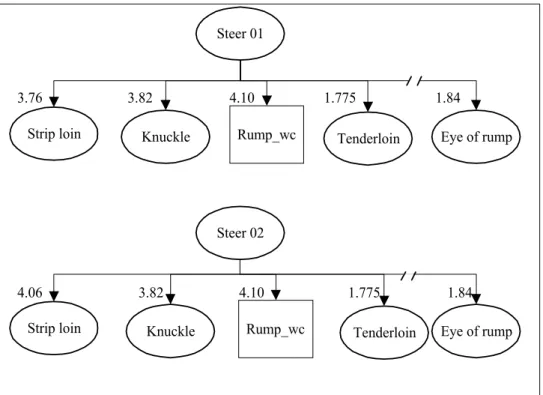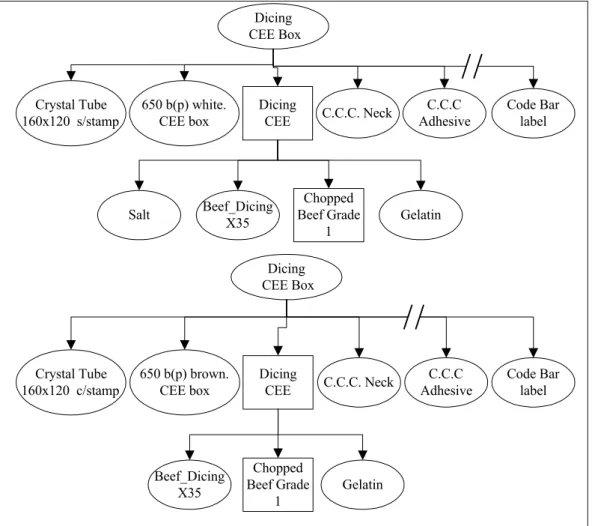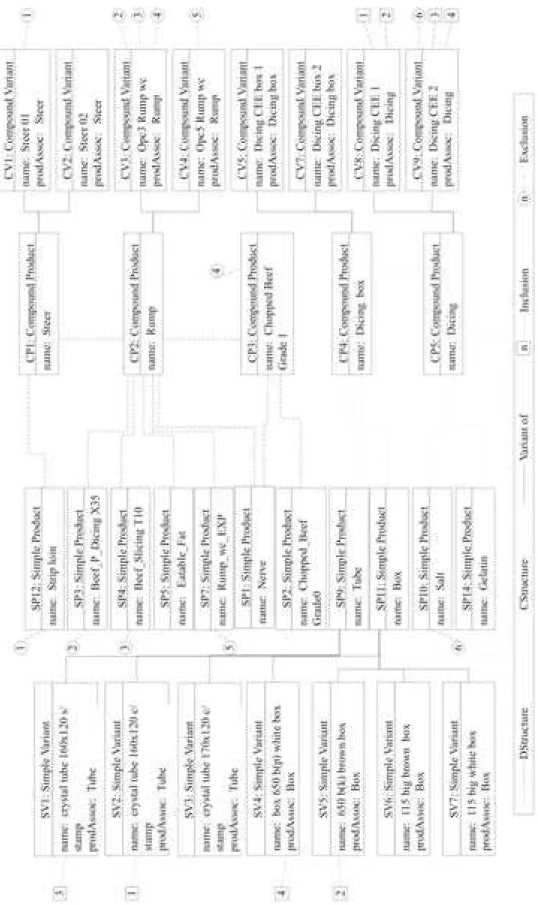ISSN 0104-6632 Printed in Brazil
Vol. 19, No. 04, pp. 491 - 497, October - December 2002
Brazilian Journal
of Chemical
Engineering
AN OBJECT-ORIENTED MODEL FOR
COMPLEX BILLS OF MATERIALS
IN PROCESS INDUSTRIES
M.Vegetti
1, G.P.Henning
1and H.P. Leone
21
INTEC, Güemes 3450, 3000 - Santa Fe, Argentina. E-mail: ghenning@intec.unl.edu.ar
2
INGAR/UTN, Avellaneda 3657, 3000 - Santa Fe, Argentina. E-mail: mvegetti@ceride.gov.ar, E-mail: hleone@ceride.gov.ar
(Received : March 5, 2002 ; Accepted: June 26, 2002)
Abstract - In recent years, many process industries have been forced to drastically increase their product variety and adopt mass customization production strategies. Many of them have found that traditional bill of material (BOM) processing systems do not sufficiently support the maintenance of the very large amounts of data (concerned with product structure) demanded by these new production policies. Due to the use of BOM technology within the framework of integrated information systems, there is a demand for both (i) a new representation of BOMs, able to deal efficiently with product variants and to handle decomposition-based production strategies, and (ii) its corresponding BOM information processing system. This paper describes a conceptual representation that integrates elements of semantic relationships with object-oriented concepts to develop a data model for a hybrid bill of materials. The proposed semantic relationships include composed-of, decomposed-into, variant-of, restriction-of, and their corresponding reverse relationships. The conceptual model has been implemented using object-oriented data-based management system (OODBMS) technology that allows creation of persistent Java objects. Preliminary tests show a remarkable reduction in the number of relationships when compared with former approaches.
Keywords: bill of materials, product structure, OODMBS.
INTRODUCTION
Market and technological forces affecting today’s competitive environment are changing dramatically. Mass production of identical products is no longer viable for many industries. Information systems and computer technology have become basic tools to face these changes. Incorporation of this technology in production management has been evolving through successive generations of information systems: material requirement planning, manufacturing resource planning, enterprise requirements planning, etc. An essential building block for the successful implementation of these types of systems, the bill of materials (BOM) is now more than a simple product structure (Gu and
Chan, 1995). With many companies pursuing mass customization, the importance of the BOM becomes even more pivotal. This phenomenon, which Van Veen and Wortmann (1992.a) call "product flexibility", has become a new factor in competition and has begun to have a great impact on product design, production processes, control systems and, consequently, the information systems that support these activities. This fact has motivated research focusing on the representation of BOMs of products having a large number of variants as well as on the development of BOM processing systems (Hedgge, 1992).
Brazilian Journal of Chemical Engineering
At the simplest conceptual level, the BOM is a list of all the parts needed to produce a finished product. The BOM is represented by a tree structure whose root is a final product, and the descendants of each node represent the components or materials necessary to produce it. The BOM is defined by Scheer (1998) using two types of entities: Part and BOM relationship. A Part can be a finished product, an assembly, a component or a raw material. Each BOM relationship defines a link between a product P (parent) and a product Q (component), when Q is one of the direct components required to produce P.
In the traditional BOM, each variant is treated as an independent product. To achieve an efficient representation of variants, Scheer (1998) outlines some modifications to this model called identical-part BOM, plus-minus BOM and multiple BOM. Van Veen and Wortmann (1992.b) describe other approaches, which are a sligthly more complex but more efficient than the previous ones: modular BOM, variant BOM and generic BOM. Chung and Fisher (1992, 1994) as well as Usher (1993) presented a BOM model with an object-oriented representation. However, none of the approaches found in the literature consider the existence of product structures involving a nonatomic raw material that goes through a decomposition process (as in the petroleum and meat industries). Let us
analyze an example from the meat industry (Fig. 1), the decomposition of steer raw material. Figure 1 shows the first level of two variants of this decomposition that only differ in the yield of the strip loin subproduct. In turn, Fig. 2 shows the decomposition of the rump_wc subproduct. Figures 1 and 2 show two different types of variants of raw material decomposition BOMs; in the first both decompositions have the same structure and different proportions but in the second all the alternatives have different decomposition structures.
In the decomposition scheme it is also possible to apply the product family concept (Scheer, 1998), but considering the product to now be a raw material instead of a finished or assembly product. Products derived from a raw material can be finished products, can enter into production processes as component parts of other products or can be further decomposed. Finished products may also have different variations in composition, as shown in Fig. 3. An analysis of Figs. 2 and 3 reveals that a given product (chopped beef grade1) may be involved in two types of relationships: composition and decomposition. Whereas the composition relationship is employed in traditional BOM approaches, the decomposition one has not been included in such models. In industries having products with these characteristics, hybrid or complex BOM structures are needed.
3.76 3.82 4.10 1.775 1.84
Strip loin Knuckle Rump_wc Tenderloin Eye of rump Steer 01
4.06 3.82 4.10 1.775 1.84
Strip loin Knuckle Rump_wc Tenderloin Eye of rump Steer 02
An Object-Oriented Model for Complex Bills 493
Brazilian Journal of Chemical Engineering, Vol. 19, No. 04, pp. 491 - 497, October - December 2002
Rump_wc
0.92 3.18
Rump_wc
Beef_Dicin g X35
Beef_ Slicing t10
Eatable_Fat _SE Chopped
Beef Grade 1
Chopped Beef grade
0
0.22 2.11 0.818 0.84 0.112
Nerve
0.8733 0.1277
Cap of
Rump Rump-nt
Rump_wc
Rump_wc_ EXP
Eatable_Fat
_SE Nerve
3.3 0.7 0.1
Nerve
Figure 2: Variations in raw material decomposition.
Dicing CEE Box
Crystal Tube
160x120 s/stamp C.C.C. Neck Dicing
CEE 650 b(p) white.
CEE box
Code Bar label C.C.C
Adhesive
Salt
Chopped Beef Grade
1 Beef_Dicing
X35 Gelatin
Dicing CEE Box
Crystal Tube
160x120 c/stamp C.C.C. Neck Dicing
CEE 650 b(p) brown.
CEE box
Code Bar label C.C.C
Adhesive
Chopped Beef Grade
1 Beef_Dicing
X35 Gelatin
AN OBJECT-ORIENTED MODEL FOR A COMPLEX BOM
In the traditional BOM where each variant is considered a separate product and in the approaches presented by Scheer (1998), the structure of each variant is stored, leading to a dramatic increase in physical storage requirements. This may also create logical data consistency problems if changes in the data associated with a specific component are not simultaneously made in all the structures in which it participates. Moreover, some of the proposals presented by Van Veen and Wortmann (1992.b), like the variant BOM, consider variants only at the finished product level, leaving aside variants of intermediate assembly products.
The approach proposed in this paper is an attempt to overcome these drawbacks. It agrees with the "generative BOM" philosophy, whereby each variant structure is derived at the moment it is required, thus reducing the volume of stored data. The aim is the development of a framework that could be used for the derivation of a BOM, independently of the process industry in which it is going to be implemented. The proposed object-oriented (OO) model allows us to minimize the coupling between products and their variants, thereby enabling us to carry out changes in product structure without affecting the associated variants. Nevertheless, the main difference between former approaches and this model lies in the decomposition relationships necessary to represent cases such as the example shown in the previous section.
The proposed model assumes the existence of similar products that have common structures and only differ in the following ways: i) the presence or absence of some components (at least one) in the structure or ii) the value of some of the characteristics that define these sets of components. This group of similar products receives the name of product family. A member of this group is denoted variant. Due to a property of similarity, a basic structure, known as basic BOM, is associated with each product family. It defines the way in which component parts are joined to form the product. From this, it is possible to derive any specific variant structure that belongs to the family, called the product BOM. A product family represents a simple or a compound product. A compound product models an intermediate assembly, a final product (intended for commercialization) or a raw material. A compound product is one that results from the assembly or processing of other products or one that can be decomposed into other products. These two
relationships are denoted in the model as
composed-of and decomposed-into (Figure 4.a) and are
described in the model by the Cstructure and Dstructure classes, which are subclasses of the structure class. This class contains the number of units of the descendent product that participate in the parent product, the classification of the structure and the restrictions that could exist for the required quantities of the component in its parent's composition. Regarding classification, a structure can be mandatory, optional or mandatory-selective.
Moreover, it is necessary to consider that for a given product not all the combinations of components are valid for either technological or commercial reasons. Therefore, when defining a structure, a mechanism that allows expression of restrictions between parts is needed. It is possible to identify two groups of restrictions between parts: obligatory and incompatible. Both must be defined to obtain a valid structure, and according to Olsen et al. (1997), all restrictions should be included in the generic structure in order to simplify the specification of product variants. For those restrictions that may occur in a composition structure, the following alternatives are modeled: quantity restrictions (Q_Restriction), restrictions between raw material instances (SV_Restriction) and constraints between product instances (P_Restriction) (See Fig. 4.b) .
Since a variant is a particular member of a product family, to represent the membership of a variant to a product family, variants are associated with products by the variant-of relationship. As there are simple and compound products, simple product and compound product variants must be introduced. The first case is represented in the model by means of the simple variant class, while the second is represented by the compound variant class (Fig. 4.c). In each compound variant, the associated compound product family is specified, making it possible to obtain both its structure and a list of the product families that are excluded from this structure (exclusion link in Fig. 4.c). Using these two elements, the Basic BOM is built for the variant. On the other hand, the compound variant may be associated with the simple variant when simple products that should satisfy a set of characteristics are to be selected (inclusion relationship in Fig. 4.c).
An Object-Oriented Model for Complex Bills 495
Brazilian Journal of Chemical Engineering, Vol. 19, No. 04, pp. 491 - 497, October - December 2002
dimensions and type are relevant to crystal tube and color and number pertaining to the Box (Fig. 3).
Applying this model to the example introduced in section 2, the object model shown in Fig. 5 is obtained. To simplify the figure, only a subset of the model objects has been considered. Moreover, Dstructure, Cstructure, exclusion and inclusion instances are represented as simple lines, because their attributes do not add more details to the example. The model shows how the steer raw material is represented as a compound product (CP1), which is decomposed by the Dstructure relationship in the SP12 and CP2 objects. At the same time, the steer product is linked to the CV1 and CV2 compound variant instances (steer 01 and steer 02, respectively). In the same way, rump (CP2) has decomposition relationships with instances SP3, SP4, SP5 and SP7 and relationships of the variant-of type with CV3 and CV4. It is important to note that, even though different rump decomposition structures are shown in Fig. 2, the Basic BOM in Fig. 5 includes just one which embraces all the rump-derived parts. By resorting to compound variant instances, like CV3 and CV4, different ways the
product decomposes can be represented. Figure 5 also depicts the inclusion (squares labeled 1-4) and exclusion relationships (circles identified 1-6) which complete the definition of the variant products’ BOM structures. It is also interesting to examine the SP3 simple product instance. It exemplifies a situation in which a given product can be part of both decomposition and composition trees at the same time. In this case, SP3 (beef_P_dicing X35) has a decomposition relationship with CP2 (rump) and a composition link with CP5 (dicing).
The proposed complex BOM model has been implemented using OODBMS technology that allows creation of persistent objects. This technology has enabled the implementation of the object model as it was conceived, without transforming it into a relational outline. The data base administrator chosen for this implementation is VERSANT, Release 5.2 (VERSANT Corporation, 1999) with the Java interface JVI (Java-Versant Interface, VERSANT Corporation, 1999). The JVI shows as Java objects the elements of both the Versant model and its interface (sessions, attributes, queries, etc.) with the data base.
Structure Component: Product Quantity
Restrictions: Restriction Type = {Man, opt, manl-sel}
Simple Product
DStructure Pcant CStructure
Compound Product Components: Structure [] Routing
Processing Time Product
id name
variants: variant[] Decomposed-into Composed-of
Structure
Restriction
Q_restriction value
type = {max, min} P_restriction
products: Product type = {Obl, Inc}
SV_Restriction Variants: Variant type = {Obl, Inc} Product Restriction-of Simple Variant (a) (b) Structure Restriction Q_restriction P_restriction
Simple Product exclusion
inclusion SV_Restriction CStructure DStructure Variant ID name AssocFamily: product Compound Product Product BOM Product Restriction-of Decomposed-into Variant-of Composed-of Compound Variant exclude: exclusion [] include: inclusion []
Simple Variant
Restriction-of
(c)
Brazilian Journal of Chemical Engineering
Figure 5:
Object
m
odel associ
ated with the exa
m
An Object-Oriented Model for Complex Bills 497
Brazilian Journal of Chemical Engineering, Vol. 19, No. 04, pp. 491 - 497, October - December 2002 CONCLUSIONS
Since for many manufactures product diversity will only tend to grow, BOM representations and BOM processing systems will become increasingly important. The definition of a BOM model is a complex task requiring new research to address the limitations of traditional approaches. In this work a new OO BOM model has been proposed. It easily manages crucial aspects that should be taken into account in a BOM representation, such as (i) efficient handling of variants and restrictions, (ii) ease with which new product structures are derived and (iii) possibility of representing decomposition BOMs (associated with production processes involving the decomposition of a raw material) and hybrid BOMs (combination of composition and decomposition processes). It should be pointed out that previous contributions were not able to represent decomposition and hybrid BOMs.
The proposed BOM model has been implemented using an OODBMS and the JAVA language, and it is currently being tested. A preliminary evaluation indicates that the number of relationships has been reduced by approximately 50% with respect to former approaches. Future work involves its integration with production planning tools.
REFERENCES
Chung, Y. and Fischer, G. (1992). Illustration of
Object-Oriented Databases for the Structure of a Bill of Materials. Computers in Industry, 19, 257-270.
Chung, Y. and Fischer, G. (1994). A Conceptual Structure and Issues for an Object Oriented Bill of Materials (BOM) Data Model. Computers Ind. Engng., 26, 321-339.
Connor, S. (1998). Enterprise Resource Planning: The Devil is in the Details, Chemical Engineering, October.
Gu, P and Chan, K. (1995). Product modelling using STEP. Computer-Aided Design, 27, 3, pg. 163. Hedgge, H.M.H. (1992). A Generic Bill-of-Material Processor Using Indirect Identification of Products. Production Planning & Control, 3, 336-342.
Olsen, K.A., Sætre, P. and Thorstenson, A. (1997). A Procedure-Oriented Generic Bill of Materials. Computers Ind. Engng., 32, 29-45.
Scheer, A.W. (1998). Business Process Engineering. Springer-Verlag, Berlin-Heidelberg.
Usher, J.M. (1993). An Object-Oriented Approach to Product Modelling for Manufacturing Industries, Computers Ind. Engng., 25, 557.
Van Veen, E.A. and Wortmann, J.C. (1992.a). Generative Bill of Materials Processing Systems. Production Planning & Control, 3, 314-326.
Van Veen, E.A. and Wortmann, J.C. (1992.b). New Developments in Generative BOM Processing Systems. Production Planning & Control, 3, 327-335.


